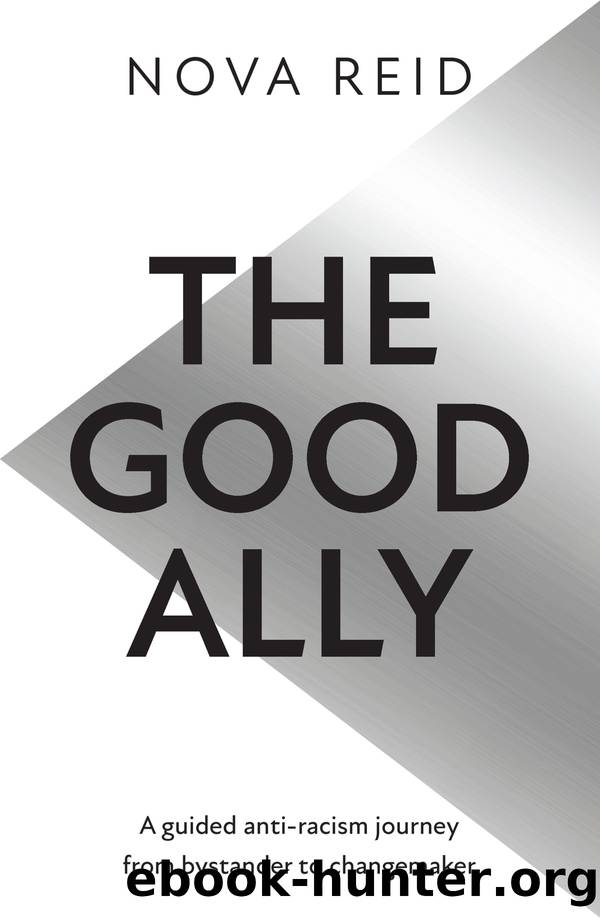The Good Ally by Nova Reid

Author:Nova Reid [Reid, Nova]
Language: eng
Format: epub
Publisher: HarperCollins Publishers
Published: 2021-08-15T00:00:00+00:00
Black women were (and still are) consistently seen as a threat to patriarchy. If white womenâs position in the ârace hierarchyâ â both beneath and fiercely protected by white men â was intrinsically linked to white men being protectors of white women, then where did Black women fall? Under patriarchy, right beneath Black men. At the bottom.
Despite historical fears about ârace mixingâ and the racist abuse that many interracial couples endured, it eventually became commonplace to see Black men and white women together in the twentieth century. However, it seemed less common (certainly according to the limited marriage statistics gathered about interracial marriage) to see Black women with white men. Black women were â and still are â plagued by centuries of negative stereotypes absorbed about Black women being âless desirableâ.
In the State of Kentucky, one former slaver who developed a relationship with one of his former enslaved Black women, wanted to marry her. It went to court and the judge was asked to rule insanity.40 And today? One of my colleagues, a dark-skinned Black woman, shared her online dating experiences and how she was often fetishised. One boyfriend never even wanted to be seen with her in public: she was his dirty little secret.
This brings to mind the true story of Dido Elizabeth Belle, the mixed-race daughter of a white British aristocrat and Navy Captain Sir John Lindsay and Maria Belle, an enslaved African in the British West Indies in eighteenth-century England. Hiding âmulattoesâ (a derogatory term for a mixed-race person with a white parent and a Black parent) out of sight from guests was a regular occurrence for aristocratic families. They were seen as not âpureâ. When her mother died, her father took Dido to live with his Uncle William Murray who was also the Lord Chief Justice of England and Wales and played an important role in the abolition of slavery. The family had great love for Dido and, even though she had inherited wealth from her father, she was still treated as someone with lower social ranking due to her race â she was made to dine separately from the rest of the family and was regularly fetishised by guests.41
Under patriarchy, white women marrying Black men did not pose a threat to economic power or to the existing social order and hierarchy. Of course, without question, these relationships posed a threat in terms of ideas of racial purity, but they didnât pose the same threat to social hierarchy, because in marriage, a white womanâs social ranking would be lowered to that of the Black man she was marrying.
bell hooks writes: ââ¦slavery ended and whites declared that no Black woman regardless of her class, status or skin colour could ever be a âladyâ.â42 Unless, of course, if Black women married white men.
If Black women were to marry white men in volumes equal to the regular ârelationsâ on plantations, their social ranking would, in theory, increase and pose a real threat to both patriarchy and white racial power.
Download
This site does not store any files on its server. We only index and link to content provided by other sites. Please contact the content providers to delete copyright contents if any and email us, we'll remove relevant links or contents immediately.
Down the Drain by Julia Fox(927)
The Light We Carry by Michelle Obama(861)
Cher by Cher(733)
Simple Passion by Annie Ernaux(702)
Love, Pamela by Pamela Anderson(573)
Zen Under Fire by Marianne Elliott(539)
You're That Bitch by Bretman Rock(524)
Novelist as a Vocation by Haruki Murakami(501)
The Foxfire Book of Appalachian Women by Kami Ahrens(500)
Kamala Harris by Chidanand Rajghatta(477)
Alone Together: Sailing Solo to Hawaii and Beyond by Christian Williams(465)
The Nazis Knew My Name by Magda Hellinger & Maya Lee(448)
Gambling Man by Lionel Barber(439)
Drinking Games by Sarah Levy(399)
The Barn by Wright Thompson(390)
A Renaissance of Our Own by Rachel E. Cargle(389)
Memoirs of an Indian Woman by Shudha Mazumdar Geraldine Hancock Forbes(386)
Limitless by Mallory Weggemann(384)
A new method to evaluate the dose-effect relationship of a TCM formula Gegen Qinlian Decoction: âFocusâ mode of integrated biomarkers by unknow(367)
